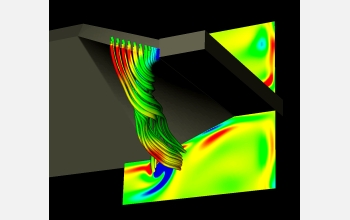Multimedia Gallery
Section of channel wall in a turbine blade near rib
Turbine blades are often subjected to extremely high temperatures. They're cooled internally with cold air flowing through serpentine channels. This image shows a section of a channel wall in a turbine blade near a roughness element, or rib, where isosurfaces of instantaneous coherent vorticity, created by shear layer instabilities on the rib, enhance mixing and heat transfer. The regions of coherent vorticity are correlated to regions of high heat transfer (blue) on channel walls. Hot spots (red) are found at corners and immediately behind the rib.
[This simulation was created at the National Computational Science Alliance at the University of Illinois at Urbana-Champaign using software developed with support from the U.S. National Science Foundation.]
Credit: Danesh Tafti and Randy Heiland/University of Illinois at Urbana-Champaign; courtesy NCSA
Images and other media in the National Science Foundation Multimedia Gallery are available for use in print and electronic material by NSF employees, members of the media, university staff, teachers and the general public. All media in the gallery are intended for personal, educational and nonprofit/non-commercial use only.
Images credited to the National Science Foundation, a federal agency, are in the public domain. The images were created by employees of the United States Government as part of their official duties or prepared by contractors as "works for hire" for NSF. You may freely use NSF-credited images and, at your discretion, credit NSF with a "Courtesy: National Science Foundation" notation.
Additional information about general usage can be found in Conditions.
Also Available:
Download the high-resolution JPG version of the image. (486 KB)
Use your mouse to right-click (Mac users may need to Ctrl-click) the link above and choose the option that will save the file or target to your computer.



 All images in this series
All images in this series